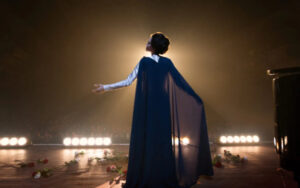MARIA: 3 ½ STARS. “Jolie gives the crowning performance of her career.”
 SYNOPSIS: In “Maria,” a new psychological biopic now playing in theatres before moving to MUBI on December 11, Angelina Jolie stars as Maria Callas, the world’s greatest opera singer, as she lives the last days of her life in 1970s Paris, after a glamorous yet tumultuous life spent in the public eye.
SYNOPSIS: In “Maria,” a new psychological biopic now playing in theatres before moving to MUBI on December 11, Angelina Jolie stars as Maria Callas, the world’s greatest opera singer, as she lives the last days of her life in 1970s Paris, after a glamorous yet tumultuous life spent in the public eye.
CAST: Angelina Jolie, Pierfrancesco Favino, Alba Rohrwacher, Haluk Bilginer, and Kodi Smit-McPhee. Directed by Pablo Larraín.
REVIEW: “Maria” finishes director Pablo Larraín’s trilogy of films about iconic women of the 20th century. Having already examined Jacqueline Kennedy and Princess Diana, this third, and final film features a commanding performance by Angelina Jolie as the temperamental opera star Maria Callas, a woman who no longer performs but admits, “There is no life off the stage.”
She may feel the absence of her voice, of performing for adoring crowds, but her life provides a dynamic backdrop for this ornate, hypnotic film. “There’s a point where self-confidence becomes a kind of insanity,” she says.
In Jolie’ hands the opera singer is every bit a diva. She is now a pill popper whose gift, a voice that once mesmerised the world, has left her, but she remains a diva nonetheless. Regal and occasionally ridiculous, she spends her days barking orders at her loyal staff (Alba Rohrwacher and Pierfrancesco Favino)—”Book me a table at a café where the waiters know who I am,” she says. “I’m in the mood for adulation.”—reminiscing about her life with an imaginary interviewer (Kodi Smit-McPhee) named Mandrax after her drug of choice and refusing to return an important call from her doctor because he said she “must” call him.
Even when there’s not much is happening in “Maria,” Jolie is captivating, emanating the larger-than-life star power that made “La Divina” beloved personally and professionally. In one playful moment Mandrax asks, “What would you say if I told you I was falling in love with you?”
“That happens a lot,” she replies with a smile.
Character study aside, the film itself is more of a mixed bag. Stunning work from cinematographer Edward Lachman and production designer Guy Hendrix Dyas create a beautiful canvas for Jolie’s work, but it feels incomplete. There are flashbacks (mostly shot in black and white) and some paparazzi style footage that provide a sense of Callas’s elevated place in the opera world, but director Pablo Larraín, working from a script by Steven Knight, is more interested in her struggles and foibles than her triumphs. It provides Jolie the dramatic space to give the crowning performance of her career so far but doesn’t allow the character the privilege of a fulsome portrait.
